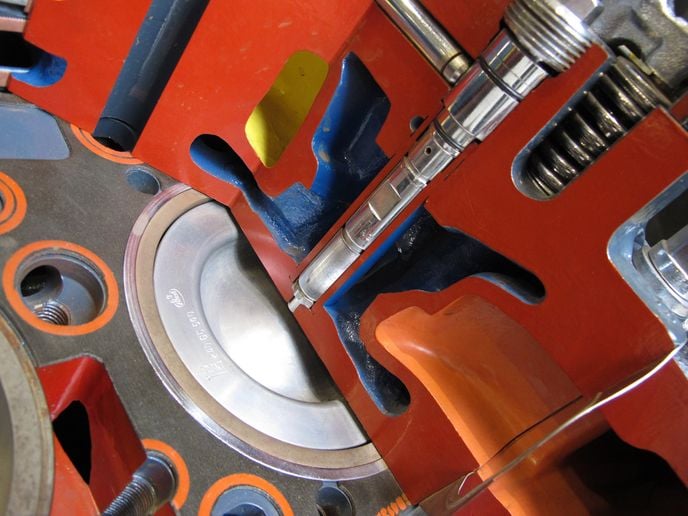Trucker Access › Forums › Diesel News › Guinea Pigs 2.0: Can Trucking Comply with a Near Impossible NOx Reduction? – On the Road
- This topic has 0 replies, 1 voice, and was last updated 11 months, 1 week ago by
 EazyRiDer66.
EazyRiDer66.
-
AuthorPosts
-
May 10, 2024 at 2:15 am #19374
 EazyRiDer66Keymaster
EazyRiDer66Keymaster

The EPA’s recently published final rule on NOx reduction pushes truck and engines makers into dangerous territory. They are adamant that the rule is technically infeasible. EPA is equally adamant it will stand.
Sneaky devils that they are, the U.S. Environmental Protection Agency released its long-awaited final rule on heavy-duty diesel engine NOx emissions, just five days before Christmas — three days before everyone packed up and shut down for the holidays. Good thing too, for the EPA, for the howls of righteous indignation are probably still ringing through the hallways over there on Pennsylvania Avenue.
We’re in for it, again, friends, if this final rule goes through. The Truck and Engine Manufacturers Association warned the EPA in its comments to the proposed rulemaking that aspects of the plan were infeasible.
To wit: “Manufacturers will not produce Option 1-compliant products because the Option 1 standards are not feasible. Accordingly, the FTP/RMC certification standards for NOx must be set at Option 2-like levels, not 0.02 g/bhp-hr. Otherwise, the standards will fail to provide the requisite compliance margins, which will render them infeasible in practice, and will cause unacceptable compliance and recall risks for manufacturers.”
EMA’s comments, along with Daimler Truck, Allison, Cummins, and others, all used language that would leave little doubt in almost anyone’s mind that the path EPA was proposing was not a good one. The final rule, published December 20, opted to go with something akin to Option 1, rather than Option 2, favored by almost all the engine-maker commenters.
In its reply to some of the negative comments, EPA countered by saying certain engines were able to meet and even exceed the proposed NOx-out standards in test cells. What EPA failed to mention was, as per observations from Daimler Truck and others, those engines were tested under the “best of the best” conditions, and certainly were not subject to 650,000 miles of wear and tear first.
Here’s how Daimler Truck described the engine upon which EPA based its Low NOX final rule (found on page 309 of the final rule): “The EPA low-NOx test cell demonstration work at SWRI was performed on a Cummins MY2017 X15 and considered only one engine rating, 500HP/1850 lb-ft, and only one exhaust configuration. The parent rating combination along with the short exhaust pipe is likely the best case scenario for tailpipe low-NOx emissions.”
While we’re dredging up flattering comments to EPA’s proposed rule (bear in mind, the final rule contains what amounts to the dreaded Option 1), here’s what EMA had to say (found on page 362 of the final rule): “Broadly speaking, EPA’s assumption that its proposed Option 1 standards and requirements are fully feasible is a fallacy. Moreover, that fallacy is premised on only one set of data — in some instances just one data point — from one still-evolving prototype engine used in one not-fully-successful experiment. That is the sum and substance of the basis for EPA’s incorrect assumption that manufacturers can design and build engine systems to meet a NOx standard starting at 0.02 g/bhp-hr, and ending at 0.04 g/bhp-hr at the 800,000 mile mark, without the need to replace any emissions-related components. … a rulemaking of this magnitude based on such scant data and such fallacious assumptions will not stand.”
There’s lots more comments along the lines published in the text of the final rule. From a lack of sensors capable of detecting such minute traces of NOx to catalyst suppliers that declined to even bid on one trucks makers product specifications, citing “unreasonably onerous durability requirements,” there’s a real risk that the hardware required to make this work are not and will not be available to meet the MY2027 deadline. MY2027 is in practical terms calendar year 2025 for the manufacturers, or just three short years from now.
The arrogance of the EPA is mind boggling. There are ample examples in print where truck and engine makers have stated that a slightly less aggressive standard could be met if the agency was willing to be a little more flexible.
CARB’s Omnibus Low-NOx Rule
Meanwhile, the California Air Resources Board’s sweeping Omnibus Low-NOx Rule is still in play. It was finalized in the summer of 2020 and sets out additional and in some cases stricter emissions targets for engine makers to contend with. That rule affects only fleets that operate in California, but it forces engine makers to build to two different standards.
One of the more contentious issues with that rule is the two-year technology development timeframe CARB wants to impose. Under the Federal Clean Air Act, the rules require a minimum of four years lead time. EPA is expected to issue final decisions early this year regarding CARB’s waiver request.
The stakes are very high, with EMA suggesting that if compliance with CARB regs becomes impossible, some truck makers would be forced to stop selling new diesel trucks in California after 2027.
By the end of March, EPA intends to release a proposal for the heavy-duty GHG Phase 3 emission standards for Model Years 2027 and later. That will add a fuel efficiency requirement to the engine makers already full plate. As many readers will be aware, reducing NOx and increasing fuel efficiency are conflicting requirements.
Who’s Left Holding the Bag?
Fleets, of course, will pay dearly for all this, one way or another. If the truck and engine makers manage to get something workable to market in time, as was the case in 2007, the technology will not have undergone enough durability testing. Heck, the warranty periods the engine makers are responsible for are longer than the time remaining for them to get product to market.
While the engine makers will be responsible for warranty on failed emission systems — and by failed, I don’t mean broken and hanging off the truck, I mean out of emissions compliance for any reason — they surely won’t be compensating fleets for downtime.
And if such product comes to market, you can bet the maintenance requirement for those systems will increase the total cost of ownership and see trucks heading for the shop more frequently than they do today.
The emissions rules changes that came in back in 2007 were nothing compared to what we face today. That technology was rushed to market to meet an externally imposed deadline, and fleets and the equipment suppliers paid the price. While some of those issues weren’t handled very well, overall, I don’t hold the truck and engine people entirely responsible.
But you can see a repeat performance brewing. The OEMs say they can’t do it, the EPA says they have to. Meanwhile, fleets are probably already submitting orders for way more MY2026 trucks than they actually need. A massive pre-buy will only add to the OEM’s difficulties.
Regulatory Activism
One has only to read the comments to EPA’s proposed rule realize the truck and engine makers are not averse to tightening emissions requirements. They have, in fact, suggested alternate approaches to the problem, none of which EPA would have any part of. Back when members of the Trump administration were contemplating tossing out a bunch of emissions regulations, the truck manufacturers lobbied hard to keep them in place. That was partially because of the investment they had already made to meet them, but also because tossing the rules was the wrong thing to do.
It’s pretty clear that the environmental regulators are trying to regulate diesel engines out of existence by dreaming up rules that are impossible to comply with, thus driving the industry toward some alternate energy source. But that’s an impossible mandate too. We’re simply not ready to go all-electric by the end of the decade.

How much NOx is too much NOx? We’re talking about difference of 15 milligrams per horsepower/hr in what’s achievable and what’s not.
As someone from a truck OEM told me after the technical session in the NOx and GHG regulations at the ATA’s Technology and Maintenance Councils fall meeting, “This is no longer a technical issue. It’s political.” (I like to keep off-the-cuff comments private to protect the careers of people who are willing to talk frankly).
But at the podium that morning, the ATA’s vice president of the ATA’s energy and environmental counsel, Glen Kedzie, shared an experience while testifying at one of EPA’s public hearings on its then-proposed rule.
“We’re usually outnumbered about 99.9 to .1 at such hearings,” he said. “At the last hearing I attended, I was sandwiched between the Assistant Attorney General for California, and Mom’s Clean Air Task Force. And that was after some little girl was holding up signs saying, ‘trucks are killing my neighbors.’”
Kedzie said it’s very difficult to have the industry’s voice represented at public hearings. My OEM confidant, echoed that sentiment, acknowledging, “We tried to get our customers to submit comments on EPA’s proposed rule, but they told us there were afraid of being seen as against clean-air initiatives.”
The problems with EPA’s final rule and how it came to be are far too complex to be explained in a 30-second sound bite on the evening news. So, applying reason to the argument against the rule is out of the question. We’d get little sympathy from a public that already hates trucks, and frankly there are some within the trucking industry lobbying hard for the rule — those who, for competitive reasons, would be happy to see the last diesel engine roll of the assembly line.
So maybe it’s time for a little industry activism.

It’s awkward to be seen as arguing against cleaning up the air we breathe, so, many remain silent in their opposition to an unworkable rule.
Kedzie pointed out that that ATA and other industry associations filed formal comments and continue having conversations with legislators, but there may come a point where the gloves have to come off.
“As a last resort, not that we’d like to go down this path all the time, but we have to weigh the pros and cons of litigation,” he said.
And that’s not without precedent.
Some of us will recall the stand-off with the National Highway Traffic Safety Administration over anti-lock brakes back in the late seventies.
Paccar, the ATA, and the Truck Equipment and Body Distributors Association sued NHTSA over a rule that mandate ABS, a technology that, at the time, was not ready for implementation.
Paccar and ATA vigorously assert that the Standard does not meet the statutory requirement of “practicability” because no need has been demonstrated for this air brake system, the cost of the system is high, and its requirements are beyond the reach of current technology. They argue that it is not a “reasonable” standard, since the failure of what they consider an unreliable device, the antilock, in a panic braking situation creates a potentially more dangerous situation than a “prestandard” vehicle because of the new, stronger braking system.
Industry prevailed that time. More than a decade passed before we saw another ABS mandate, and then, the technology was up to the challenge. In fact, now it’s the basis for a host of other advanced safety systems.
For the sake of the billions of dollars that surely will be dumped into supporting a technology that’s just not ready to comply with an overly ambitions and politically driven rulemaking, I hope it doesn’t come to litigation, but I wouldn’t unhappy if it did.
-
AuthorPosts
- You must be logged in to reply to this topic.